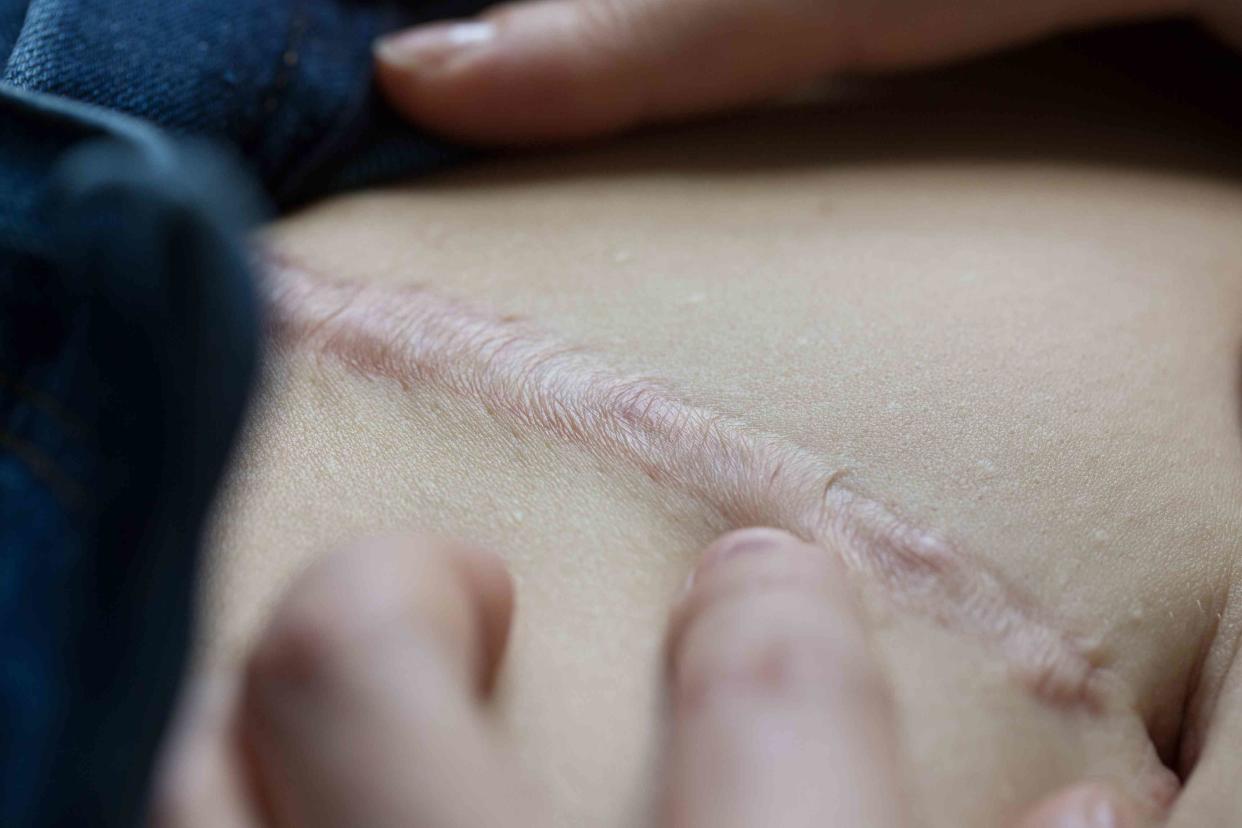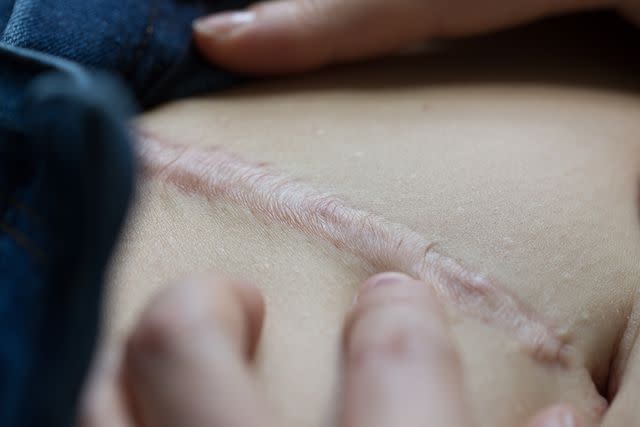What to Expect After a Hysterectomy: Scars and Aftercare

Boris Zhitkov / Getty Images
Medically reviewed by Renita White, MD
A hysterectomy is a surgical procedure performed to remove the uterus. Following the surgery, people who have had their uterus removed can no longer bear children or have menstrual periods. Scarring is common following the surgical procedure.
This article discusses the types of scars you may develop after a hysterectomy, how to minimize scarring, and other possible side effects of the surgery.

Boris Zhitkov / Getty Images
Types of Hysterectomy Scars
Several types of scars can develop following a hysterectomy. The scar you end up with will depend on the type of hysterectomy you have done.
Abdominal
An abdominal scar will develop in people who have had their uterus removed through the abdomen. There are two types of abdominal scars following a hysterectomy:
Vertical
Horizontal
Both incisions are made above the pubic hairline. A vertical scar from the surgery runs from the pubic hairline to the belly button, and a horizontal scar runs left to right above the pubic hairline. Both types are visible and prominent. The scars in this type of hysterectomy surgery will be roughly 4–6 inches long.
The Use of the Abdominal Method
While abdominal removal of the uterus is performed on many people, surgeons typically reserve this type of surgery for people who cannot go through other minimally invasive procedures.
Vaginal
A vaginal scar after a hysterectomy is not visible because it occurs within the vagina or around the cervix. The procedure is performed by making a small incision within the vagina, detaching the uterus, and removing it through the vaginal opening.
Laparoscopy
Laparoscopic procedures are minimally invasive. During this surgery, small cuts are made in the abdomen. The laparoscope, a narrow, fiber-optic instrument with a camera on the end, is inserted through a cut in the belly button.
It gives the surgeon a view of the uterus and the surrounding area, making a larger incision unnecessary. The surgeon will access the uterus and remove it with small tools placed through the other incisions, Dime-size scars are left behind.
How Many Scars Will I Have After Laparoscopic Surgery?
Since laparoscopic surgery requires the use of several tools, a person undergoing the procedure can expect at least two or three scars.
Robotic
Robotic surgery technology combines robotics and high-definition, three-dimensional (3-D) magnification to perform a hysterectomy. Tiny surgical instruments are also used in this procedure to remove the uterus.
To perform this surgery, abdominal incisions are made. There will be roughly four or five cuts so the robotic arms and other tools can enter the abdomen. Once inside, the robotic arms move to where they need to be to cut out and remove the uterus. The scars left after a robotic hysterectomy are similar to those that develop following laparoscopic surgery.
Research has found that the scars from robotic surgery are minimal, and typically this type of procedure leaves people satisfied with their level of scarring compared to other, more invasive techniques.
Can You Avoid Hysterectomy Scars Altogether?
All surgery comes with the risk of scarring, and hysterectomies are no different. You may be able to minimize scarring following a hysterectomy by taking proper aftercare measures.
Learn More: Different Types of Hysterectomies
How to Minimize Scarring
There are several ways you can minimize scarring following a hysterectomy procedure. They revolve around aftercare routines, lifestyle changes, and medical treatment.
Proper Aftercare
It can take roughly six to eight weeks following the surgery to recover. Because of that, you’ll have to adhere to a proper aftercare routine to limit the risk of complications and minimize scarring.
The best way to minimize scarring through aftercare is to:
Change any dressings at least once per day or every time they get wet or dirty while in the hospital.
Avoid baths or submerging the wound in water.
Keep your scars out of the sun after the bandages come off, or use a broad-spectrum sunscreen with a sun protection factor of 30 (SPF 30) or higher.
Massage the scar (when the surgeon gives you the go-ahead to do so) to help soften it.
Use silicone gels or sheets on the area to keep it moisturized as it heals.
Risk Factors that Contribute to Scarring
Scarring occurs because the body has to replace damaged or injured skin with dense connective tissue. Several factors contribute to how a scar will heal, including:
A person’s skin type
Where the scar is
The direction of the wound
Age
Nutrition
Quit Smoking
Smoking is harmful to all aspects of health. Regarding surgery, smokers are more likely to experience a delay in healing because of its effects on the immune system’s ability to heal wounds. Quitting smoking can help combat slow wound healing.
What Is Hypertrophic Scarring?
Hypertrophic scarring is an unusual response to surgery or other injuries to the skin that results in a thick and raised scar.
Hydration
Keeping your scar hydrated is a great way to minimize its appearance. In the same way that drinking water throughout the day helps keep the body hydrated, hydrating wounds with moisturizing gels or sheets made from silicone is also essential.
Silicone is safe to use on a wound following surgery and can fully hydrated the wound as it heals. Keeping your scar moisturized will also reduce the risk of developing a hypertrophic scar.
Healthy Diet
What you eat affects your body’s ability to heal wounds. If you are deficient in nutrients vital to wound healing, such as vitamin A, vitamin C, or zinc, your immune system will not be able to perform at its best, causing the wound to heal much slower. Eating a diet rich in whole foods and nutrients can support proper healing and minimize scarring.
How Long Does It Take a Scar to Fade with Proper Care?
The process of scar fading isn’t an exact science, and since people are different, the amount of time it takes for a scar to fade will vary, too. The type of scar also matters. Larger, more pronounced scars will take longer, whereas smaller, fine-line scars will fade quicker. In some cases of small scars not caused by surgery, it can take up to two years for the scar to fade.
Medical Treatment
If a scar is particularly bothersome after you have healed from a hysterectomy, you can opt for a medical treatment to help minimize the appearance of the scars, depending on size, type, and other factors.
Some possible options are:
Collagen injections
Cortisone injections
Laser resurfacing
Surgical scar revision
Learn More: How to Prevent or Minimize Surgery Scars
Treating Side Effects
Following a hysterectomy, you may experience some side effects. These are only temporary but can be challenging to cope with while you recover. Some side effects and their treatments include:
Emotional changes: Some people experience grief or sadness following a hysterectomy, and in some cases, it can result in depression. In that case, meeting with a mental health provider can help. Treatments may include antidepressants and counseling.
Menopausal symptoms: If someone has their ovaries removed during a hysterectomy, they will enter menopause. Treatments for the symptoms of menopause can include hormone replacement therapy implants, injections, or tablets.
Vaginal discharge: Vaginal discharge following a hysterectomy is normal and can last up to six weeks. No treatments usually are necessary.
Bladder/bowel issues: Following a hysterectomy, constipation and urinary tract infections can be common. Constipation can be treated using laxatives or stool softeners, and UTIs may require antibiotics, depending on the type of infection. Increasing your consumption of high-fiber foods can also help.
These side effects may not occur in everyone who has a hysterectomy.
Life After a Hysterectomy
While recovering from a hysterectomy, you can return to your normal daily activities. While you will not be able to conceive, you may still enjoy a healthy sex life once you have healed.
In some cases, people who had experienced pain with sexual intercourse prior to a hysterectomy may find pain has resolved after surgery. This is especially true if the uterus is removed to address a health disorder causing discomfort during sex.
Learn More: Hysterectomy Interview With Lesa - Pain With Periods & Sex
Summary
Hysterectomy scarring is unavoidable because of the incisions made during the procedure. There are many types of hysterectomies; some will cause more prominent scarring than others.
Practicing good aftercare routines is the best way to avoid noticeable scarring following a hysterectomy. This involves keeping the wound clean and hydrated, following all aftercare instructions provided by your healthcare provider, and making necessary lifestyle changes, such as eating a diet rich in nutritious whole foods and quitting smoking.
If the scarring is particularly bothersome, you can explore medical treatments to minimize or reduce scarring following a hysterectomy.

